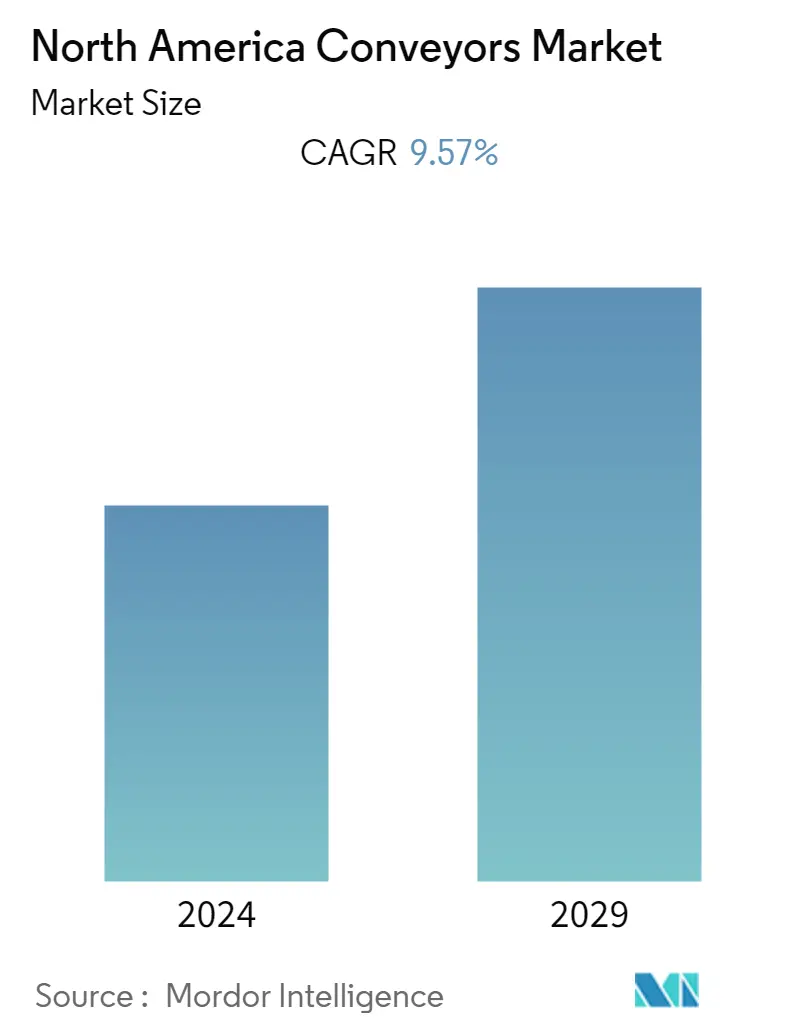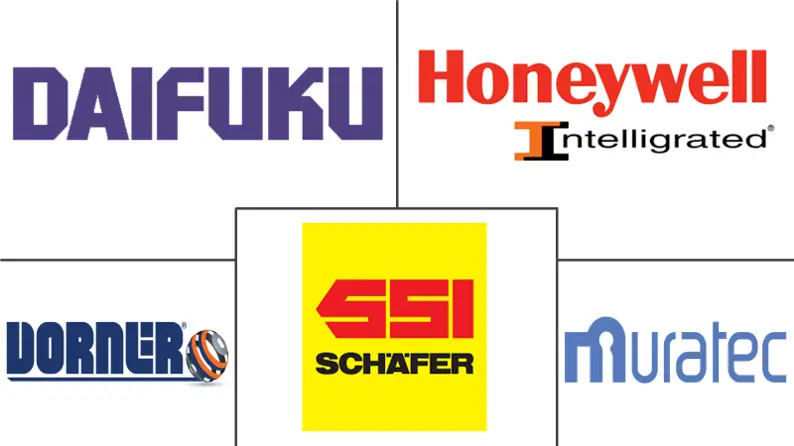Market Size of North America Conveyors Industry

| Study Period | 2019 - 2029 |
| Base Year For Estimation | 2023 |
| Forecast Data Period | 2024 - 2029 |
| Historical Data Period | 2019 - 2022 |
| CAGR | 9.57 % |
| Market Concentration | Medium |
Major Players
*Disclaimer: Major Players sorted in no particular order |
North America Conveyors Market Analysis
The North America Conveyors market is expected to register a CAGR of 9.57% over the forecast period from 2020 to 2025. With the rapid growth in stock-keeping units (SKUs), wholesalers and distributors find it difficult to make informed decisions about their operations. This drives the requirement for smarter use of labor, equipment, and technology. The main factors driving the demand for automated material-handling systems, such as conveyors, are cost savings, labor efficiency, and space constraints.
- Modern manufacturing facilities in North America rely on new technologies and innovations to produce higher quality products at faster speeds, with lower costs. Implementing more smart software and hardware proves to be the only feasible way to survive in the current competitive market. This technology provides the manufacturers in North America with many significant and measurable benefits, such as increased throughput of materials and decreased operating costs and. Optimizing the first mile, using material-handling automation, improves company profitability and customer satisfaction throughout the warehouses in North America.
- With the increase in air traffic (from almost 769 million in 2009 to approximately 1.1 billion in 2019), according to the United States Department of Transportation, coupled with the substantial increase in air freight, the United States will invest in the expansion of its existing airports and the construction of new ones, during the forecast period. The investment is expected to drive the market for conveyors in the country. Canada's trade-based economy and tourism are witnessing very high demands from emerging markets, such as India, Mexico, and Brazil. With the increase in international air traffic and Canada being the hub for traffic between Asia, Europe, and the Americas, the government is planning to capitalize on this potential, thereby driving the region's demand for conveyors.
- In November 2019, US-based material handling equipment provider, Sweet Manufacturing Co, launched its new Enclosed Belt Conveyor, which expands its offering of conveyors, which includes Flite-Veyor Flat Bottom Drag Conveyors, Flite-Veyor Round Bottom Conveyors, Formed Channel Belt Conveyors, and Quick-Key Spool Belt Conveyors. The fully-enclosed belt conveyor with patent-pending design features idler access doors, auxiliary belt alignment rollers, a self-cleaning tail, heavy-duty liners, and built-in sensor ports. In the recent Virtual interpack Booth 2020, US-based Dorner Mfg Corp showcased its 2200 Series, FlexMove, and the AquaGard 7350 V2 Series conveyor systems. The company is mainly targeting applications in food, beverages, pharmaceuticals, cosmetics, consumer goods (non-food), industrial goods, packaging and packaging production, and confection and bakery industries.
- Honeywell Intelligrated Technology Study released in July 2020 revealed that warehouses, distribution centers, and e-commerce fulfillment providers anticipate boosting automation investments such as conveyors as they optimize operations and address social distancing guidelines. Two-thirds of e-commerce companies are willing to invest more in automation due to increasing consumer expectations. More than half of United States companies are increasingly open to investing in automation to survive evolving market conditions by the COVID-19 pandemic. While almost all companies have experienced positive business outcomes from automation solutions they have implemented, the cost is the most considerable restraint to further investment. According to the study, more than half of the consumer-packaged goods industry sees the value of implementation as a significant barrier in automation.
North America Conveyors Industry Segmentation
Conveyor systems are mechanical devices or assemblies that are used to transport various materials with little effort. There are different kinds of conveyor systems, usually consisting of a frame that supports either wheels, rollers, or a belt, upon which the materials move from one place to another. The scope of the study is currently focused exclusively on the North American region.
| Product Type | |
| Belt | |
| Roller | |
| Pallet | |
| Overhead |
| End-User | |
| Airport | |
| Retail | |
| Automotive | |
| Manufacturing | |
| Food and Beverage | |
| Pharmaceuticals | |
| Mining |
| Country | |
| United States | |
| Canada |
North America Conveyors Market Size Summary
The North America Conveyors market is experiencing significant growth, driven by the increasing demand for automated material-handling systems. This demand is fueled by the need for cost savings, improved labor efficiency, and the optimization of space within manufacturing and distribution facilities. As modern manufacturing in North America adopts new technologies and innovations, conveyors play a crucial role in enhancing product quality, speed, and cost-effectiveness. The expansion of air traffic and the growth of e-commerce further contribute to the market's expansion, as companies invest in advanced conveyor systems to streamline operations and meet rising consumer expectations. The retail sector, in particular, is a major driver of conveyor demand, with retailers increasingly automating their warehouses to improve efficiency and accommodate growing online sales.
The competitive landscape of the North America Conveyors market is characterized by the presence of both domestic and international companies, with major players focusing on product innovation and strategic partnerships to strengthen their market position. The United States, as a leading investor and innovator, is at the forefront of adopting advanced conveyor technologies, driven by the need to enhance industrial automation and reduce labor costs. The market is also influenced by regulatory standards, such as the FDA Food Safety Modernization Act, which emphasizes the importance of cleanability and sanitation in conveyor systems. As space constraints and high commercial leasing costs continue to challenge end-user industries, the demand for conveyor systems is expected to grow, offering substantial opportunities for market participants.
North America Conveyors Market Size - Table of Contents
-
1. MARKET DYNAMICS
-
1.1 Market Overview
-
1.2 Market Drivers
-
1.2.1 Increasing Demand for Handling Larger Volumes of Goods and Improving Productivity
-
1.2.2 Rapid Growth of E-commerce
-
-
1.3 Market Restraints
-
1.3.1 High Cost of Implementation
-
-
1.4 Industry Value Chain Analysis
-
1.5 Industry Attractiveness - Porter's Five Forces Analysis
-
1.5.1 Bargaining Power of Suppliers
-
1.5.2 Bargaining Power of Buyers
-
1.5.3 Threat of New Entrants
-
1.5.4 Intensity of Competitive Rivalry
-
1.5.5 Threat of Substitutes
-
-
1.6 Assessment on the impact due to COVID-19
-
-
2. MARKET SEGMENTATION
-
2.1 Product Type
-
2.1.1 Belt
-
2.1.2 Roller
-
2.1.3 Pallet
-
2.1.4 Overhead
-
-
2.2 End-User
-
2.2.1 Airport
-
2.2.2 Retail
-
2.2.3 Automotive
-
2.2.4 Manufacturing
-
2.2.5 Food and Beverage
-
2.2.6 Pharmaceuticals
-
2.2.7 Mining
-
-
2.3 Country
-
2.3.1 United States
-
2.3.2 Canada
-
-
North America Conveyors Market Size FAQs
What is the current North America Conveyors Market size?
The North America Conveyors Market is projected to register a CAGR of 9.57% during the forecast period (2024-2029)
Who are the key players in North America Conveyors Market?
Daifuku Co. Ltd, Schaefer Systems International, Inc., Honeywell Intelligrated Inc., Dorner Mfg. Corp. and Murata Machinery USA, Inc. are the major companies operating in the North America Conveyors Market.

